


The exhibition Square is a direct result of Neža Knez’s two-month residency in New York. It references her new life experience, new surroundings, the culture, and the people. Neža Knez carried out a public street-cleaning action on Brooklyn’s Broadway Avenue. She selected a square in front of the entrance to her apartment where she lived; determining the location and time – she cleaned 22 days, every day from 8 am to 9:30 am. The street on which she worked was full of random passers-by, especially those carried out everyday routines on the street: walking to work, drinking coffee, opening nearby stores. In these passers-by, she awakened an interest, yet she did not wish to engage in verbal communication with them, or even later explain to them that she was carrying out an artistic action. Her answer was only that she wishes to have a clean square.
What does the square represent the artist?
During her first experience in the United States, Neža Knez had the impression that the American flag and the square are visual elements that most determine those surroundings. Even the series of photographs documenting her working process awaken painterly associations. For her, the persistent cleaning of the ground represents the closest approximation to a direct painting experience that she has ever gone through.
On the exhibition itself, the artist presents photographs, video, objects, and excerpts from her journal writings. Some works were created during the action itself, others came about later in response to it. The documentary video and photographs record the process of cleaning, the location, the happening and people’s reactions. The documentation reveals the basic information about the street, its nature, incidental passers-by, community and culture.
In general, the project Square carries several characteristics of Knez’s previous artistic actions, which reveal every day through physical activity. With them, she creates situations that are inconceivable in the chosen environment yet are unusual enough to carry the potential to interrupt the flow of the urban routine. By including random passers-by, Neža Knez provokes an immediate reaction and thus emphasizes the importance of genuine experience and cooperation, which are both integral parts of her activity.
*Nina Skumavc – Gallery P74
Video link: http://www.e-arhiv.org/diva/index.php?opt=work&id=1357
]]>Deus (»god«) + ex (»from«) + machina (»machine, device, object«)
The term deus ex machina is a Latin term which means »God« or supernatural being that has gained several meanings and explanations over the course of two millennia. This superior force or person at the last moment resolves an unsolvable situation without following the previous logic of the relationship or overcoming common sense.
In the first phase, the work was based on conversations with five-year old children about drawings they have made, depicting their most important things to them and their vision of the future. The drawings were used as a source material from which they then selected the most important elements to them (»head of the Ninja Turtle – it can zoom, the butterfly wings – we can fly, the ambulance car – so that we are fast, ornaments on the wings – because they are beautiful, the bridge – we can go over the lava or the flood..«). Then they assembled their pictures into a single image and named it: »A machine that will make a better world, a machine that will help us..«.
This collaboration, raised a number of questions: Is there such thing as »unspoiled nature« in children, or are they already the projection of us and the world that surround us? How do they perceive the concept of the future, even though they are not yet fully aware of it? What, when and where is our present? Are solutions by those who concern the consequences of the present always recognizable as rational?
It is very possible that incredible things will come out of that.
In cooperation with Oton Župančič’s kindergarten, group Mice.










]]>
Our century is based on visibility, but it is precisely in this incarnation when it often happens that things are overlooked. The artwork The Love (T)Akt tries to alert, or even transform, the perception of reality. It offers something spectacular, strange, or something that “does not have anything to see”, and encourages us to look at it more closely. It is not (as in love) seen in objects, but everyone can find access to their own pleasure. The work does not hide or reveal Nothing, except for the viewer who wants to see it.
Nothing but gentle printmaking paper in their phenomenal materiality are placed in the gallery space accompanied by of the raw sound recording and the inscription on the paper that complements and gives the tact. This embodied Nothing is like love, the absence of absence, the body as the object of desire, and at the site of this withdrawal, two distinct (sexual) positions, the body of the Self and You. As a naked body, a clean surface, the surface is again and again, the body in love. With the fascination of pure, delicate printmaking paper, which is merely a bearer of “beautiful” (the beauty itself remains unmistakable), I try to extract a deeper essence, because I believe it is concealed in the split the Beauty from its bearer. From form, assumption, matter, author, viewer, symbol. Straight to nothing, which is unbreakable, abstract, yet realistic.






Statement on paper:
Love lasts as long as the positions of I and You are ready to accept the image of the other as the only image. But it is necessary to see not only the object of desire, but also something else as long as they want to see this something that is lingering in the back. This desire to see is love. This is a place where there is nothing to see, nor to understand, there is only pleasure. That is why neither I nor You, as long as there is love, do not see behind the image of the other, eternally nothing but a new superficial manifestation of the other. So, nothing but love.
]]>
*TEXT ABOUT WORK AND VOICE WILL BE SEEN SOON…
]]>Performance is a presentation of research, which led me to the question of misunderstanding (reading in the Italian language, which I do not understand). With this verbal “non-sense“, I try to make the listener think beyond the language heard. Intangible is related to different forms – illusions. With this performance, I am interested in the endurance of participation. How long they are willing to stay polite with receiving misunderstanding information. When it comes to the point of collapse of the listener or when they start to think beyond the words, which opens discussion on a different level. The voice enables the speech and at the same time, it’s like a hole in speech. This voice is beyond meaning, which unable something symbolic. I could say that the less we hear, the more we want to hear. This pure voice reduces the letter and there is seen life itself. It wasn’t authorized by the law of the letter, but it was the law itself, which is crowding out normal law.
My readings were in: Viterbo (Italy) in Slovenian language – gallery space (first research on residency in Italy), Milano (Italy) in Italian language, which I don’t understand – library in Milano, Reka (Croatia) in Italian language – gallery space, Ljubliana (Slovenia) in Italian language..



 ]]>
]]>
Objects on the floor testify about the bodies and their effort, which was seen (first day) thought the performance or better say kettlebell lifting competition. The exhibits objects are on some way a remnant of action, which isn’t represented like document, because these objects themselves have a strong presence.
This sport with strong Russian tradition, which is connected with the hard work, where presented weights were used for weighing cargo on ships, I connected with a gallery event and with different views through the eyes of cultural workers. Event establishes differences and at the same time connections between culture workers and (in this case) athletes and fans. This is also evident through the vote for the winner, which is open to all participants of the event.
View on the muscle mans and women’s, which are showing its strength, durability, and accomplished technique of lifting, can also transform in view of the dancing figures on pedestals, where is visible a fight with the own body.
Action and the rest after, re-investigate hard tangible aspects of a work – communication, sense, and public. In a way, I try to connect my personal past – as a former athlete – to the present, which led me to a different perception of this sport and I try all that show through unique artistic expression







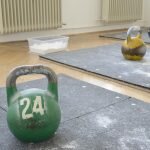
]]>
Work it was represented in two different forms. On the first day, I made a performance in which I was read various Slovenian stories in the Slovene language while sitting under the hayrack. The hayrack is one of the most recognizable Slovenian national objects. However, I see it as a very strong symbolic item, kind of a statue or a monument, which is attached to our national history, collective memory, and language. Many stories, novels, and poems were written about hayracks, they either speak directly about them or just describe events, somehow connected to them, for instance as a hiding place for soldiers on the run, a love relationships scene, as a children playground. After the performance, my body was gone and the only objects left was the hayrack, the table and the book I was reading and recordings of it. With these elements left I try to keep those stories and my language materialized and make them closer to the spectator.
I ask myself what happens when the moment of spectator’s misunderstanding is exceeded and a discussion is opened on a different level. With this verbal ‘non-sense’ I try to make the audience to think beyond the language heard and the objects seen. Work is intended to stimulate spectator’s reactions and possible interest, leading him to different reflections and make new sense out of them.


 ]]>
]]>
(Jože Barši: “The thing of art or rather operation of art is nothing, or if you wish art is for-nothing/non-sense. Wordpad for-nothing, which creates for-nothing is the back side of a good artwork, which in its procedure, in its structure functions like a logical machine (that must be). On the other side however the idea for-nothing bound on the object, which is unrecognizable, undefined, undesigned, formally opened and ontologically uncertain allow us to think.“)
During the three-day action, which was held in Germany, I was on a transitional meadow full of residents passing by and I dug a soil there. This diggings slowly – after its own will – started to transform in kind of hole or gutter. As soon as the material physically stopped me, I decided to bury the hole back in the original form – that, of course, isn’t totally possible.
I was interested in reactions from people who passed by, stopped and some of them helped me and asked questions. But I answered only one question: “What is this?-The hole.“ They didn’t get anything else, except confirmation, which they perceived for themselves as well.
The third day, when action was “done“, I invited seventeen people to answer one question: “What do you think about this?“. After I received their answers on A4 format, I had half an hour of introduction about my action and I tried to explain, that they themselves put the life in the artwork.
Work is strange, unplaceable, it produces a scar in everyday life. We can’t install it in a known shape of artwork. It is alive, it transforms from one to another and produces differential mental reactions. The action forces the “viewer“ to think. When the object disappears it is replaced by a thought – memory. The viewers themselves produce artwork, on another words, that they themselves are artwork. Work is alive, it changes, and again and again, it interprets itself. It produces thoughts beyond its own, and even if there is no form, it exist just like documentation of something. Words, thoughts, and interpretations are alive, this is evident from the notes of people, asked for opinion of “this“.


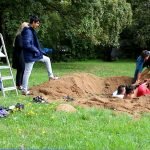




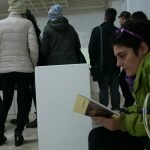



 ]]>
]]>
Written numbers on the pillar (in a gallery space) are an image of our way from home to the gallery space. Work is one of the attempts of our walk, which is determined by our voices. Dual, which starts at the same time it becomes visible through our entry into the gallery space, then through a gesture of writing steps and with an exit from the gallery. During the opening, a walk allignment of two bodies happens. That becomes a form of controlled movement research; by voice (that counts steps) which dictates movement of the body.
move – voice, Neža – Martina, city – gallery space


 ]]>
]]>
This work is a reaction to relocation of the exhibition of nominees for OHO award. It is made by walking from Ljubljana (where I live) to Maribor (UGM gallery).
The experience of walking is not only a matter of theory, it avoids external presentation. Walk is now only a memory and this incapability of spectator’s insight into my personal experience has its own aesthetic value. Work is not fixed in history as a document but is somehow placed in life itself. There is no transition of experience, which is exactly what should be presented here, but is intentionally missing! Instead of an expected presentation of what I made, I arrange what is closer to experience and does not only allude it. This statement rebuts itself, plays with opposites like: yes – no, here – there, visible – invisible, personal experience – representation… When talk about that not representing – with this negative statement already represent something: my thought, caused by my walking.
Statement on the wall:
There is no representation here,
because with every documentation of an experience we disguise the authentic one experience.
Deceiving images, filled with (visual) meanings, are not experienced world or my own experience, but only an image of it. What is seen or experienced is always first and before what is visible/will be on view.
But, isn’t this statement already a representation of something?
]]>
I make myself not to see for ten days (24 hours per day), thereby trying to enter the other dimension of perception of the world around me. I realize that with our ability to see we are detached from space and objects; we feel them only superficially. When confronted with »blindness« our body and everything around us feels different. We start to construct space from the beginning and build some sort of an »interior« space. This interior space is full of places we have inhabited not only with our bodies but also with our touch, smell, and hearing. I eliminate completely my field of vision, by that awaken my other senses, and then enter the space, see how my perception of it changes and how my senses react.
With this work, I am trying to move the viewer towards my experience of “blindness“. I am placing the viewer in front of documents of my experience and simultaneously create conditions in which my project becomes a story. I am not trying to represent or illustrate the experience of blindness, I try to present my “blindness” only.
I got acquainted again with known and familiar places but experienced them with other senses. I cannot be blind the way blind people are and the viewer cannot be blind as I was. The blindness of the blind people, my blindness and blindness of the viewer is not the same, it doesn’t want to be the same and by no means can be the same. The project is opening the field of difference between the actual blindness, the experience of blindness and the materialization of it. Assuming only one correct interpretation would be a failure.
Three different portraits made without seeing the person portrayed. One is based only on touching the person, one on memorizing it and one after an audio description of its looks. 64 pages long visual diary, filled with hand drawings and notes and drawings on paper. Diary, made using Descriptive Experience Sampling method. For 24 days (7 days before and after “blindness” and 10 days during it) my alarm clock rang 10 times per day to remind of describing the inner experience of the present situation – space, people, surrounding sounds.











 ]]>
]]>
Sound installation Background in which I am presenting six minutes long audio work, made from seven hours long audio recording I made when being blind. The cuts are divided with a beep which reduces the poetical quality of the work and transforms it into plain documentation of experience.
Sight, hearing, and smell are senses which can function from a distance. They enable us to enter the place where the object of our perception is; somehow we are already there even before approaching it closely.
I am presenting my work to the listener in a darkened room where an audio narration is played – a narration of surrounding sounds, accompanied by my voice. Through the darkened black-box and spatially placed speakers, the recording forces us to perceive sounds we can easily miss or ignore in our daily life: the humming of a computer, distant music, water running from the fauce… And the voice of a person describing the experience of it in different environments or situations.
]]>The work could also be called »Graffiti under the fingers«. I have translated textual graffiti, drawn on walls of Ljubljana’s buildings, without any censorship, to tactile form, Braille. These “Graffiti” are white plaster casts fitted on Ljubljana façades; the only way to read them is to touch them… I enabled blind people to enter the dialogue with their environment. I believe that blind people live in the world determined by strict functionality and graffiti are a complete opposite of that. Their functionality is questionable and there are unnecessary for survival, yet they are necessary because making diversities.
With this work, I am thinking about the translation of visual and am alluding to the increasing popularisation of translation of artworks in art institutions. Rethinking sense or nonsense of translation. What do (blind) people get from these translations? What changes with translation? What happens when translating visual imagery to a tactile form, what happens when simply just rewriting a text? What does the translation take or add and in what way does it change the text or image?


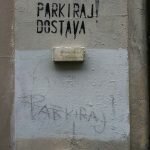




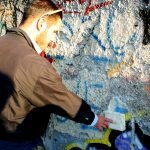
 ]]>
]]>
The work constitutes itself through duality. It is playing with the viewer’s look and thinking of the listener.
Video represents five people, sitting thoughtfully, obviously listening to something we cannot hear. Sudden body moves make relatively static recording dynamic and interesting. We watch their minimal movements, expressions, and reactions, evasive moments otherwise difficult to obtain. Spectator of the artwork gets to see the listeners without hearing the same stories. He asks himself: what is it that these people are listening to? Why do they respond differently from one another?
Five people are listening to five different stories taken from tabloid newspapers. Short articles are being read precisely and seriously; the combination of trivial contents and sophisticated reading of them seems absurd. The listeners do not know that they are being recorded. Their reactions to what they hear are therefore authentic; one could say that the video represents the truth, their character, the non-pretending, uncensored expressions of their thoughts. The moment we put the headphones on, the quietness is substituted with the same stories the people in the video are listening to. Work unveils the relation between the narration of the body language and narration of the stories played, between quietness, listening and attention.
]]>We have to learn how to speak but to learn something we first need to have the idea of it.
The thought of what will be said influences the face expression, our body language, the tone of our voice… The voice forms our body language, our body language expresses what was said. Frequently, however, it comes to the incompatibility of a person’s thought and its expression.
I asked ten people to slowly and clearly pronounce Slovene alphabet as if talking to a deaf person and, without them being aware of it, I video recorded them when speaking. Seeing adult people trying to distinctly pronounce the alphabet as if learning it for the first time, seems odd, somehow bizarre. They are focusing on something we usually do completely automatically.
They start to talk simultaneously but due to their own rhythm, the synchronicity eventually collapses. The new rhythm is maintained, however, new harmonious polyphony. Each person, its portrait and voice, is played on its own monitor. When looking distantly at those ten monitors placed side by side, people seem as choir members, one after another finishing their stanzas in silence. But if we get closer to each monitor, its voice and its facial expression stand out from before integral whole. Each person’s focus on spoken is visible; preparation of the body, focus on adequate articulation. Here and there we notice individual essence, always present but only sometimes visible. The unspoken voice is seen before it is actually said.



]]>